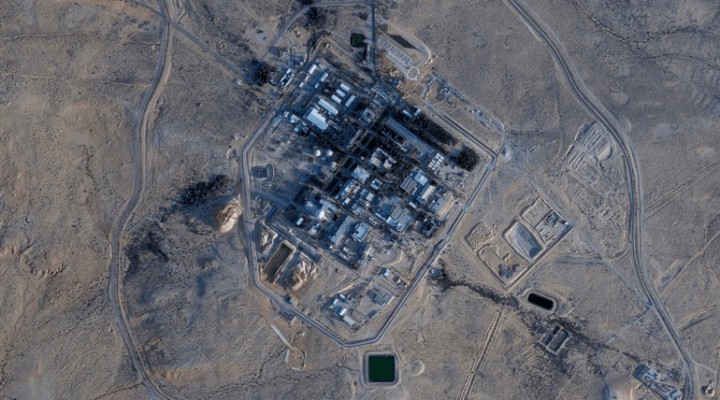Syria launched a missile towards Israel: payback time?

The Syria air defence system near the capital Damascus launched a missile as Israeli jets were hovering above the occupied Golan Heights and bombing Syrian army targets near the Golan Heights. The Syrian missile landed 30 kilometres away from the most protected and secret Israeli Dimona nuclear reactor in the Negev. The distance between Damascus and Dimona nuclear site is 296 km, long enough that it seems astonishing that it was insufficient for the Israeli interception defence system to neutralise the missile. Was this promised Iranian retaliation for the Israeli sabotage attack on the Natanz nuclear reactor or a simple errant missile?
Israeli media and spokesperson of the Israeli army downplayed the event, describing the missile as an “errantsurface-to-air S-200 (SA-5)”. It is striking that Israel’s most sophisticated interception system failed to down the missile. Others recalled a similar confrontation in 2019 when a stray Syrian anti-air missile hit Northern Cyprus. Former Defence Minister Avigdor Liberman took the opportunity to criticise Prime Minister Benyamin Netanyahu, accused of “being asleep during the night shift” and failed to intercept the Syrian missile.
It is unusual for Israel not to offer proof of a missile launched against one of its most sensitive sites. A fin or engine of the missile would have made it possible to determine if it was a 1967 SA-5 missile or a 2012-Iranian Fateh-110 surface-to-surface missile – that Syria manufactures under the name of M-600 – as claimed by an Iranian IRGC general. If the Iranian version is plausible, the idea that the missile was a Syrian-Iranian “message” and that the time has come to settle the open account is conceivable. This has triggered a reaction from Israeli asking to be told the truth about the missile launched from Syria and the massive explosion at the Tomer defence missile motors manufacture outside the town of Ramle.
The SA-5 surface to air missile is 10.8 meters long with radio waves, infrared flight guidance systems and aerodynamic manoeuvring wings. Modern jets maybe able to avoid this old soviet missile that downed an Israeli F-16 in 2018. Therefore, when the missile reaches its range and fails to destroy the target, it is equipped with self-destruction apparatus to explode before getting to the ground. In contrast, the 8.9-meter-long Fateh-110 is a surface-to-surface missile that follows a trajectory with satellite guidance by knowing the target’s position. Only the third (Fateh-110 block 3) and fourth-generation (Fateh-110-D1) of Fateh has a 300 km range. The fourth-generation Fateh-110-D1 (Fateh Mobin) also has an infrared imaging sensor for thermal guidance. Both Syria and the Lebanese Hezbollah are equipped with the Fateh-110.
Israel claimed the missile launched from Syria exploded in the sky, although images shared on social media implied a powerful ground explosion. However, the Israelis confirmed that the missile was not intercepted. Therefore, the idea of explosion in the sky after over 250 km of trajectory seems excluded because the missile reached around 266 kilometres range before the impact.
The understandable conclusion is that Israel wants to avoid escalation with Syria and Iran. The version of an “errant missile” is convenient. It is supposed that the self-destruction mechanism has failed to allow the missile to explode after reaching the ground. By offering several contradictory versions, Israel would like to leave this event behind and avoid details. It remains a humiliation that a 1967 surface-to-air missile managed to sneak in and avoided all its recently upgraded interception missiles.
Had Israel opted for the Fateh-110 version, it would mean the decision to fire the missile came from President Bashar al-Assad himself, telling Israel that payback time has come. Moreover, it would have also implied the level of harmony between Syria and Iran, where both allies have a common interest in retaliating against Israel’s numerous violations with a missile. For Iran, it would be a response to the Israeli Natanz’s sabotage. This version acutely embarrasses Prime Minister Netanyahu, whose over 1000 attacks on Syria failed to achieve Israel’s objectives.
Syria and Iran are showing Israel that they are strong allies, sending a unified message. The Israeli Iron Dome system definitely appears to be a failure, promising little protection when multiple missiles from different locations are launched against Israel in time of war.
The US also opted for a soft-version, conveniently adopting the SA-5 version: CENTCOM commander-general Franck McKenzie blamed Syria’s “incompetence” for the “errant missile” to downplay the event, adding he did not believe it was “an intentional attack”. The US is not in a mood to be dragged by Israel to a tit-for-tat and has other priorities. Besides, Israel was the aggressor and had been unlawfully bombing Syria for years. The multiple Israeli attempts to spoil the US-Iranian rapprochement are exasperating the new US administration.
For President Bashar al-Assad, McKenzie’s version is also convenient. Of course, Syria can’t compare its arsenal to the modern Israeli military capability where Israel and the US invest billions of dollars annually to maintain military superiority over Middle Eastern armies without necessarily imposing deterrence. However, a short missile is enough to raise the Israeli awareness that its continued violation of the Syrian sovereignty may lead one day to a front where Iranian missiles will flood its sky and its modern interception system would fail to intercept.
All parties are happy with the blurred Israeli-US version of the event. It is terrifying for Israel and the US to believe that a nuclear reactor (Dimona) has become an easy target even for an old missile. That is a strategic deterrence that was sent to Israel by an “errant” missile during a battle between wars. It seems clear that when payback time is due, Israel will be vulnerable.
 TheAltWorld
TheAltWorld 
0 thoughts on “Syria launched a missile towards Israel: payback time?”